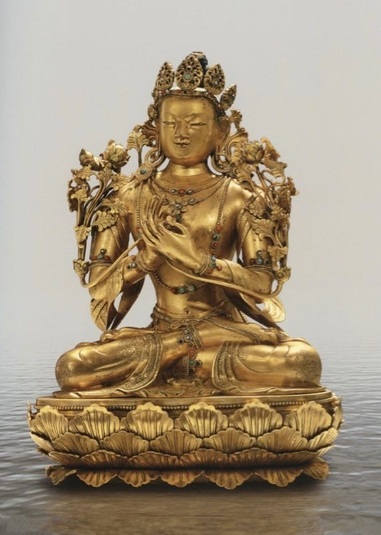
Item: Bodhisattva - (unidentified male)
| Origin Location | China |
|---|---|
| Date Range | 1600 - 1699 |
| Lineages | Buddhist |
| Material | Metal, Mercuric Gild |
| Collection | Private |
Classification: Deity
Appearance: Peaceful
Gender: Male
Bodhisattva Figure (unidentified), likely from a set of the Eight Great Bodhisattva. (See a definition of the term bodhisattva. See other Kangxi sculpture with layered petals).
In Himalayan and Tibetan art terminology ‘bodhisattva’ is used to designate a male figure included as one of the realized (relating to the Bodhisattva levels of accomplishment) students of Shakyamuni Buddha based on the Mahayana Sutra literature. In art ‘bodhisattva’ is descriptive and synonymous with the term ‘peaceful appearance.’ In Theravada Buddhism the word ‘bodhisattva’ refers exclusively to Shakyamuni as a prince prior to his complete enlightenment under the bodhi tree.
There are different groupings of the more important of the bodhisattvas. In Tibetan art, for paintings and sculpture, Manjushri, Lokeshvara and Vajrapani are a commonly found group based on the Mahayana Sutras and the later Kriya Tantra literature. (See a list of the most common bodhisattva groups).
The group known as the Eight Great Bodhisattvas, including the three mentioned above, have in addition: Maitreya, Akashagarbha, Kshitigarbha, Samantabhadra and Nivarana-vishkhambhin. When appearing as a set of sculpture it is very common for only the first four to be individually designated with an identifiable attribute. For Manjushri there is the sword and book. For Lokeshvara there is Amitabha on the crown, a large lotus blossom and an antelope skin. For Vajrapani there is the vajra scepter. For Maitreya there is the stupa on the crown, a water flask or a Dharma Wheel, or all three plus an antelope skin. For the remaining four bodhisattvas, especially with sculpture, it is most common for them to be without an identifiable attribute, which means that many bodhisattva sculpture are unidentifiable. The four unidentified figures would of course be almost identical in style and quality to the first four, just without an attribute.
Some sets of Eight Bodhisattva sculpture in Tibet, China and Mongolia might have no identifiable attributes at all for any of the eight figures. Sculpture such as this function as secondary figures, seated or standing, to a large Shakyamuni or Amitabha Buddha - the centerpiece of a shrine or a temple.
This figure has the two hands at the heart in the teaching gesture while holding the stems of two flowers blossoming over the two shoulders. The crown is in a Kangxi period style. He wears earrings, a choker, necklace, a long necklace, armlets, bracelets, anklets and heavenly garments, seated in vajra posture above a lotus seat with four variegated over-lapping levels of petals. A ring of beads around the top of the lotus represents the pistil and stamins of the flower.
The sculpture is assembled from several individually cast pieces. The flowers on the right and left are wire and repousse construction, a hammered metal working technique. Likewise, the layered lotus petal base is repousse in manufacture. The mercuric gilding covering the entire surface of the object also functions to hide joint work and points of assembly of the different cast pieces.
Both the figure and lotus base are in excellent condition with some small signs of wear and abrasion. The gilding appears original with few losses if any. The inset stones may or may not be original to the sculpture. Comparing this work to the other three known pieces from the same workshop, believed to be in the Palace Museum, the Zhiguan work is in a superior condition.
Jeff Watt, Beijing, July 1st 2018
In Himalayan figurative art there are eleven different appearances, or figurative forms. Male and female bodhisattvas have Peaceful Appearance. The terms bodhisattva appearance, peaceful appearance, deva appearance and sambhogakaya appearance are all synonymous and refer to both male and female peaceful figures. The term bodhisattva has two meanings, an [1] abstract Buddhist meaning and [2] a descriptive art meaning. The art meaning refers to appearance only and not to the abstract function category of the figurative subject. Peaceful subjects can have more than one face and two arms however the ornaments and manner of dress is consistent and uniform with all peaceful figures.
Thirteen Peaceful Ornaments:
- Five Silken Garments - Eight Jewel Ornaments
Five Silken Garments: - Blue Silk scarf - Five-coloured Crown Pendants - White Upper Garment - Lower Skirt Garment - Sleeves (or Long Scarf) for Dancing
Eight Jewel Ornaments: - Crown - Earrings - Choker Necklace - Armlets - Middle Length Necklace - Long Necklace - Bracelets - Anklets
There are of course different lists and different ways to enumerate the Thirteen Ornaments. Sometimes a belt and girdle are listed.
(See another sculpture from the same workshop).
Jeff Watt 3-2019
Sotheby's New York, March 1996.
Exhibition: RMA Masterworks, January 28th, 2021
Thematic Sets
Sculpture: Kangxi Style Crown (Metal)
Sculpture: Kangxi Style, China
Collection of Zhiguan Museum of Fine Art
Collection of Zhiguan (Sculpture)
Buddhist Figure: Bodhisattva List
Buddhist Figure: Bodhisattva Main Page
Buddhist Deity: Bodhisattva (Masterworks)
Collection of Zhiguan Museum of Fine Art (RMA 2019)
Sculpture Set: Kangxi (Layered Petals)
